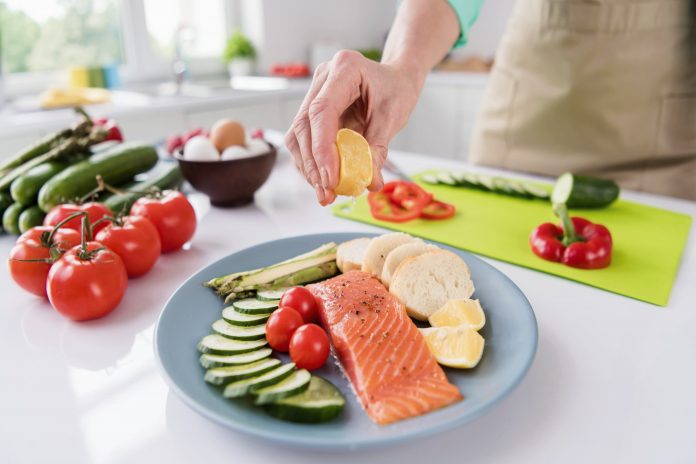According to a 2004 review on muscle changes with aging, muscle mass decreases approximately 3–8% per decade after the age of 30. This rate of decline increases even more after the age of 60.
Losing muscle can translate to loss of body strength, an increase in fat mass, and pose a significant risk for a lack of mobility and balance and heightened risk for falls and injuries. Additionally, it can cause a decrease in bone density, increase joint stiffness, and contribute to a small reduction in stature.
Along with strengthening muscles with exercise and resistance training, seniors can help fight muscle loss by eating foods high in protein. Discover what the best protein sources are for seniors to help build muscle into your or a loved one’s diet!
10 Foods to Eat to Gain Muscle for Seniors
These are some of the best foods for seniors to eat to gain muscle and to prevent unnecessary loss of muscle mass with aging. Consider pairing them together or with other beloved foods and seasonings to help with lack of appetite if needed.
1. Meat
Animal meats are one of the highest sources of protein and valuable in senior health, supplying an approximate 7 grams of protein per one ounce. Unfortunately, red meat and other animal proteins may get the boot, as they may be too tough and difficult for seniors to chew.
However, such products can be more tolerable by adding ground meat into soft taco shells, pasta dishes, and casseroles. Adding gravy and other tenderizing agents can also lend a softer product.
2. Fatty Fish
Fatty fish supply considerable amounts of protein while providing heart health benefits thanks to their omega-3 fatty acid content. They also tend to be an appropriate consistency for seniors to chew.
Healthy, fatty fish includes salmon, tuna, and mackerel. Pair with roasted veggies for a complete, well-balanced meal.
3. Soy Foods
Tofu may be a significant protein alternative for individuals eliminating or reducing meat intake. Tofu is made from soybeans, and it is a plant-based protein that holds the flavor of the ingredients it becomes paired with.
Tofu’s less utilized cousin, tempeh, is also a significant plant-based protein source that can be used in salads, sandwiches, egg dishes, or paired with roasted veggies. It has a firmer texture than tofu.
Steamed or roasted edamame can be a high protein but light choice for a snack. They can be popped from the shell when eating or you can purchase shelled edamame to make snacking easier.
4. Eggs
Eggs are a high protein and nutrient-dense food that can be a healthy addition to include a balanced diet. A large egg provides 6 grams of protein and essential amino acids.
You can dismiss the worry of the dietary cholesterol found in eggs, as the 2020 Dietary Guidelines actually encourage their intake in moderated amounts. In fact, if giving up on eggs, you may be missing out on high-quality fats and fat-soluble vitamins.
Along with being sunny side up or scrambled, eggs may also be mixed into casseroles and pancake batter or hard-boiled and paired with salads and sandwiches.
5. Milk
Drinking milk at the dinner table is much more than a childhood memory. Milk supplies adequate protein and calcium to encourage both muscle and bone strength, respectively.
Offering a glass of milk with meals or even as a snack offers 8 grams of protein! Milk can also be added to smoothies or shakes to boost protein and nutrients in the diet.
6. Cheese & Other Dairy
Another dairy option for best protein for seniors is cheese. Add additional protein to meals with the use of cheese – sprinkle atop salads, layer a slice on a sandwich, and drizzle cheese sauce onto potatoes and other veggies.
Cottage cheese and Greek yogurt are also encouraging foods for muscle growth, supplying about 12-15 grams of protein per serving. Pair with fresh or dried fruit for a sweet but nourishing snack.
7. Beans
Beans are both protein and fiber-packed, making them food to eat to support muscle and digestive health. And with seniors already at risk of muscle weakness and constipation, increasing bean intake is highly encouraged.
Any variety of beans can be added to soups, casseroles, salads, tacos, burritos, or pasta dishes to bulk up fiber, protein, and minerals.
8. Nuts
Almonds, pecans, walnuts, and several other nuts are significant sources of both healthy fats and protein. They are also a convenient snack on the go while also offering crunch to salads, rice bowls, and several other dishes.
9. Peanut Butter
Peanut butter is an appreciated substitution for crunchy nuts, particularly if seniors have difficulty chewing and swallowing them. Add peanut butter into smoothies and oats, dip with carrot sticks, smear on apple slices or a banana, or simply enjoy by the spoonful for rich protein, healthy fats, and nutrients.
Eight grams of protein are in two tablespoons of peanut butter. If you do not want to eat this full amount in one sitting, spread it out throughout the day to easily add a protein and calorie boost.
10. Protein Powders
Although dietitians and nutritionists encourage eating whole foods over supplemental products, plant-based and whey protein powders may be a valuable alternative for seniors with a reduced appetite.
Protein powder can easily be added to shakes, oatmeal, or simply stirred with milk to bump up the protein.
Discuss with a dietitian and primary care provider to determine which type of protein powder may be best for you and your nutritional needs.
Best Protein for Seniors Recap
Eating a variety of foods high in protein can help fight off the natural muscle loss that comes with aging, especially when paired with exercise. There is no single food seniors should focus on getting as the best protein source. The best protein food sources are foods tailored to each person and ones they will enjoy eating.
Animal-based foods like meat, fish, dairy, and eggs are some of the highest quality foods for protein. However, plant-based foods such as soy, nuts, beans, and nut butter can also provide a significant source of protein as well as provide many other health benefits.
Protein powder can be added to drinks and foods as a way to boost protein fairly dramatically in the diet. However, it’s best to consult with a doctor to determine if and how this should be added.






